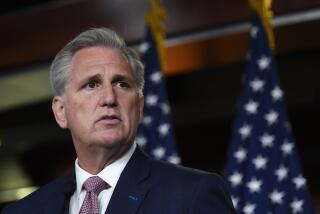Anybody Got a Plan for Banks?
- Share via
Banking reform is now one hot political potato being chucked about between Republicans and Democrats, both inside and outside the House and Senate. Now, after months of haggling, the two houses are sitting down over the weekend to hammer out a compromise bank bill. But the legislation has been so thoroughly watered down, it’s almost beneath discussion--leaving a wide-open field for all sorts of kibitzers.
Take New York Gov. Mario M. Cuomo. The Democrat, an official non-candidate for President, has his own ideas about banks and the credit crunch. In a detailed and provocative economic growth plan--sent, for the partisan fun of it, to Vice President Dan Quayle--he proposes that the Federal Reserve system invest up to $25 billion in major banks that agree to make loans to small and medium-size businesses. The banks would repay the Fed after 10 years. Cuomo said the infusion of federal capital would trigger $100 billion in new bank lending.
“This wouldn’t be a loan. It would be the Federal Reserve taking an equity position in the banks . . . . Unless Washington takes action to strengthen the healthier banks, Washington will end up holding the bag for the bankrupted ones.” A real nice try, governor, but Washington is a thin reed to lean on these days: It’s having a hard time in general and is already overexposed on the savings-and-loan bailout.
A spooked Washington, fearing a nasty repeat of the S&L; debacle, has retreated en masse from the Treasury’s wise and much-needed proposal for major reform to allow banks to enter new businesses to raise new money. The House bill to provide $70 billion in new borrowing authority for the dwindling bank-insurance fund is far less useful than the Senate bill. That one allows banks to branch across state lines and expand their ability to sell insurance. Fortunately, both bills provide for early federal intervention in troubled banks and end the unofficial “too big to fail” policy that protects all deposits, even those over $100,000. This should ease pressure on the bank-insurance fund.
The ultimate bill must recapitalize the insurance fund, allow interstate banking and expansion in the field of insurance but eliminate the Senate cap on credit-card interest rates. That won’t immediately relieve the credit crunch, but it would help banks generally.
More to Read
Get the L.A. Times Politics newsletter
Deeply reported insights into legislation, politics and policy from Sacramento, Washington and beyond. In your inbox twice per week.
You may occasionally receive promotional content from the Los Angeles Times.










